There’s a whole lot of talented folks out there making gun leather these days, and a RevolverGuy could get dizzy trying to keep up with them. A lot of these are “mom and pop” shops manned by a single craftsman, or a small team of them. They make fine, beautiful, custom products to order, but this personal touch often comes at the cost of increased price and wait times.
On the other end of the spectrum are the big operations which produce large quantities of standardized products from extensive catalogs. Most of these started as “mom and pop” makers, but grew into high volume companies in order to meet the demand for goods.
One of these big outfits is the highly successful Galco International, a company that started in 1969 as a small family operation under the name, “The Famous Jackass Leather Company.” Founder Richard Gallagher ran a successful Chicago operation that specialized in horsehide holsters, but as demand grew for his products, the company changed names in 1980, and shortly thereafter moved to Phoenix in 1983, so he could grow it into the industry giant that we know today.
When I was offered the chance to review a Galco product for the RevolverGuy audience, it was a little hard to pick one. Galco offers a wide variety of belts and holsters, suitable for everything from competition to concealed carry to outdoor use, so selecting just one representative was a bit of a challenge.

I’ve carried a 1-7/8” Smith & Wesson Model 640 in a Galco pocket holster for decades though, so it was time to try the other end of the spectrum. This time, I’d play with finding a fit for a bigger gun, which in this case turned out to be a 6”, L-Frame, Model 586.
Big Guns For Big Jobs
There aren’t a lot of folks carrying medium or large frame revolvers for personal defense these days, myself included. Small frames, yes, but the bigger guys, not really. These days, when it comes to defensive chores, the medium and large frame guns usually get assigned to the jobs where they don’t have to be carried around much, like defending the home or business.
But when we start talking about fun and work in the outdoors, that’s another story. Whether you’re a hunter, a hiker, a camper, a woods bummer, a farmer or rancher, or just somebody who likes the smell of fresh air with a tinge of gunsmoke, there’s few choices as good as a medium or large frame wheelgun. The traditional favorites in this class tend to wear longer tubes, for increased sight radius and velocity. This makes them more capable, but also more difficult to carry.
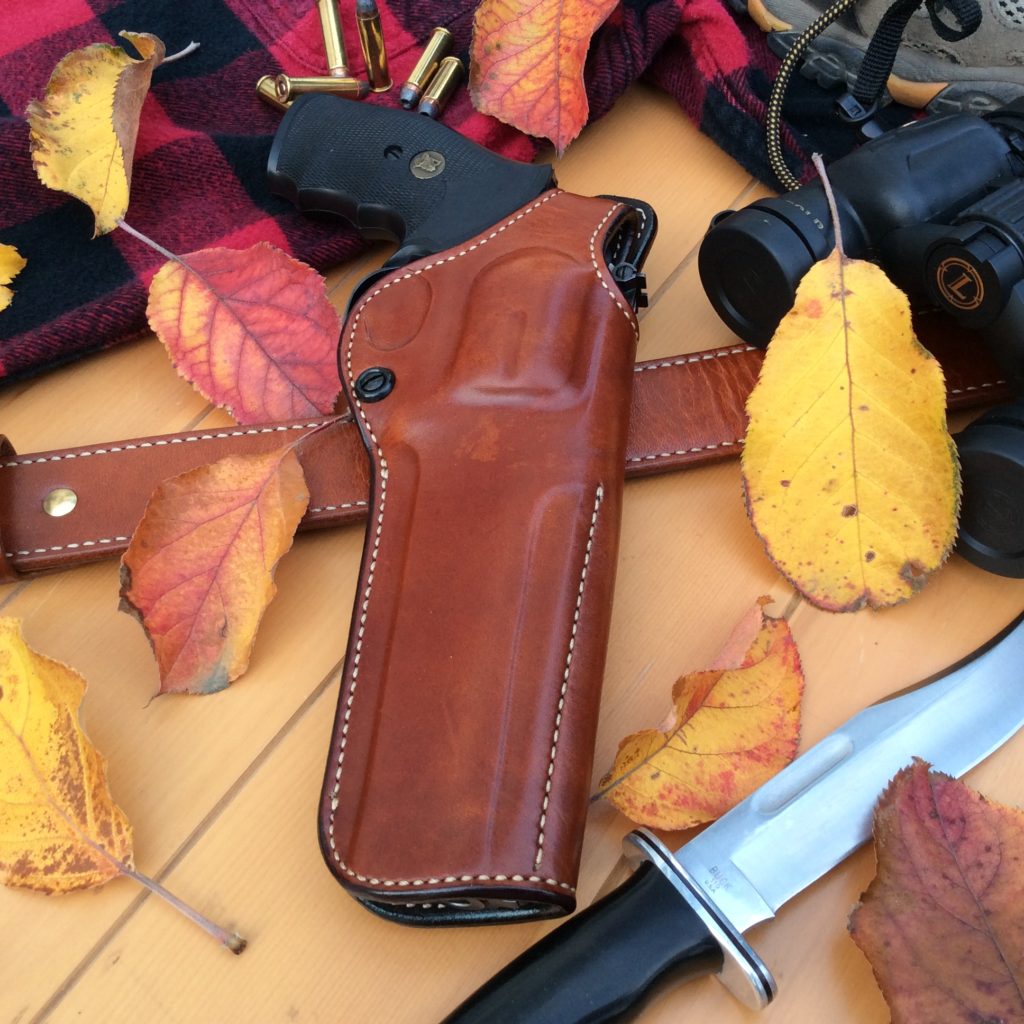
I’ll admit there are some strong advantages to chest or shoulder carry and some situations where these methods are probably the best choice, but I’ve always preferred belt carry, so into the Galco catalog I went in search of a suitable rig. What I finally settled on was the Phoenix Belt Holster, carried on the SB5 Sport Belt.
Building On Rock
The belt is the heart of any carry system, and it has to be up to the task or all is for naught. You can have the greatest gun, carried in the greatest holster, but if you hang it all on a cheap strap, you’re in for trouble.
So we start with the belt. Galco’s gunbelts are made from premium grade, full-grain, steer hide. This vegetable-tanned leather is tough and durable, and won’t lose its shape or rigidity easily like a lesser quality leather. This is important, because the gunbelt will need to support a lot of concentrated weight, and if it sags or folds, then it won’t maintain the holstered gun in a stable, fixed position. The gun will flop and shift around on the belt, compromising comfort, concealment, and an efficient draw.
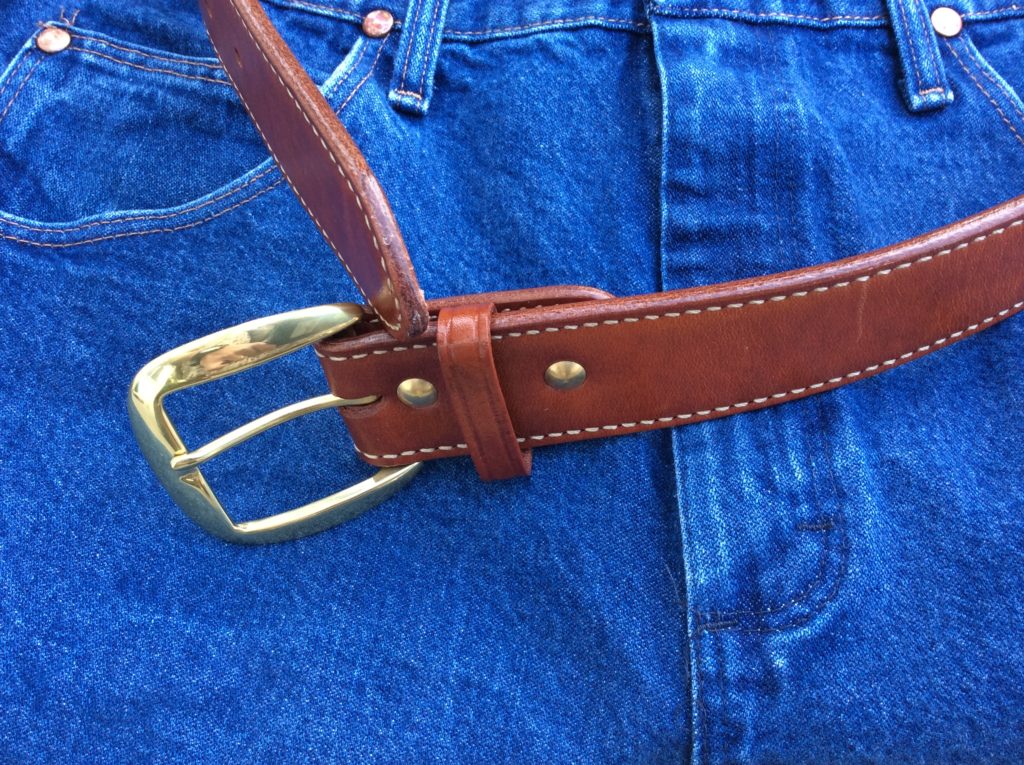
The SB5 Sport Belt is made from two layers of this hide. The outer and inner layers are cut and assembled in a way that the grain of the leather is aligned, for maximum stability. The two layers are joined by attractive stitching, using nylon thread that resists staining, stretching and rotting. The stitching also adds to the stability of the belt.
The SB5 Sport Belt is cut straight, not contoured. This means it will take a little longer to “break in” and obtain the gentle curve that makes a belt feel more comfortable, but it will. The belt is 1-3/4” in width, which means it will fit the 1-3/4” loops on the Phoenix Belt Holster perfectly, eliminating the slop that can allow a holster to shift around.
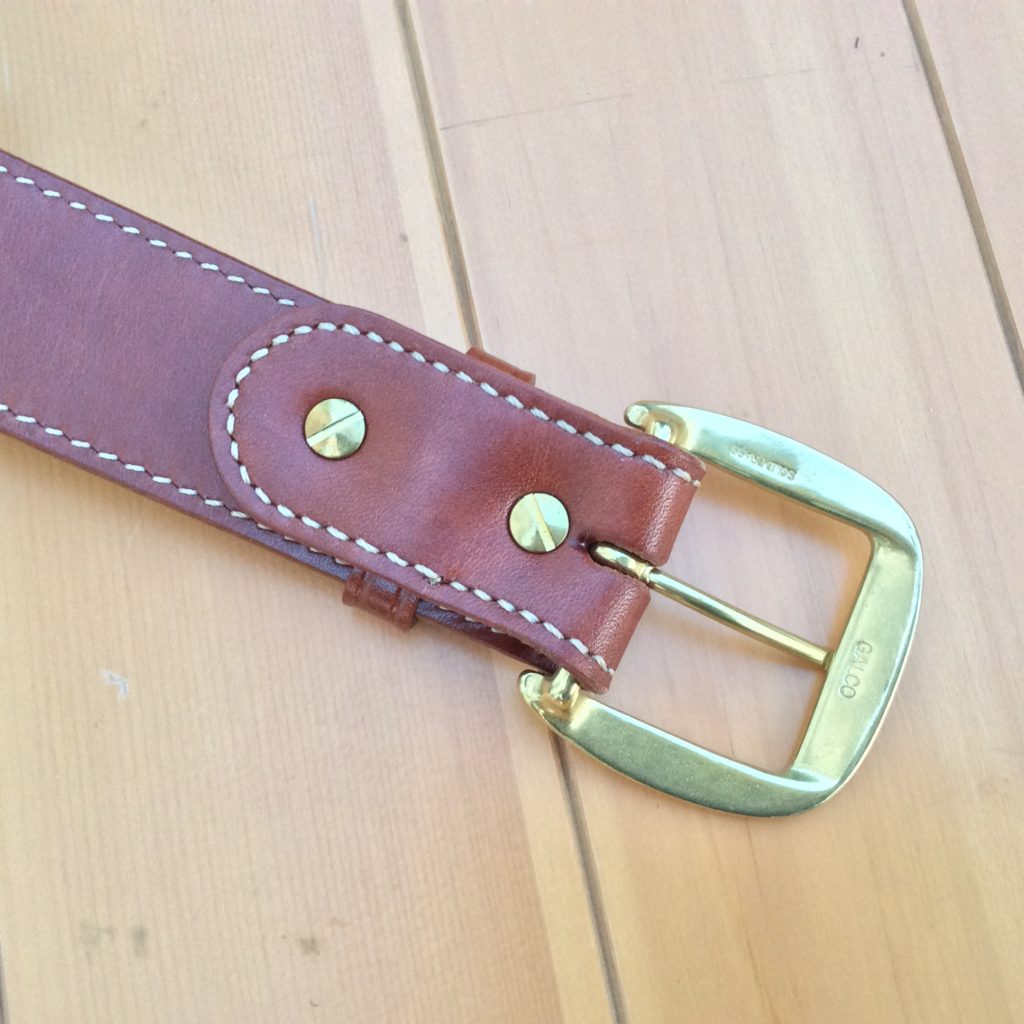
My belt was ordered in tan, and has a brass buckle (secured with Chicago screws, as it should be) that looks great with the beautiful, light russet finish of the leather. The leather edges are all nicely burnished, polished, and sealed. It’s a high quality gun belt that will do an admirable job of supporting the weight of an outdoorsman’s revolver.
No Gun Buckets Here
With the proper foundation established, we can now look at the holster. The Phoenix Belt Holster is actually billed as the Dual Position Phoenix Belt Holster in some of the company’s literature, because it has the ability to be worn as either a strong side or a crossdraw holster, by virtue of a unique belt loop system. The belt slots in the rear panel are cut so the holster can be worn on the strong side at a forward cant, but one corner of the rear panel is not stitched closed, which allows the belt to pass underneath the rear panel at that point and then emerge through one of the belt slots. When the belt is threaded in this latter fashion, the holster can be carried on the opposite hip as a crossdraw.
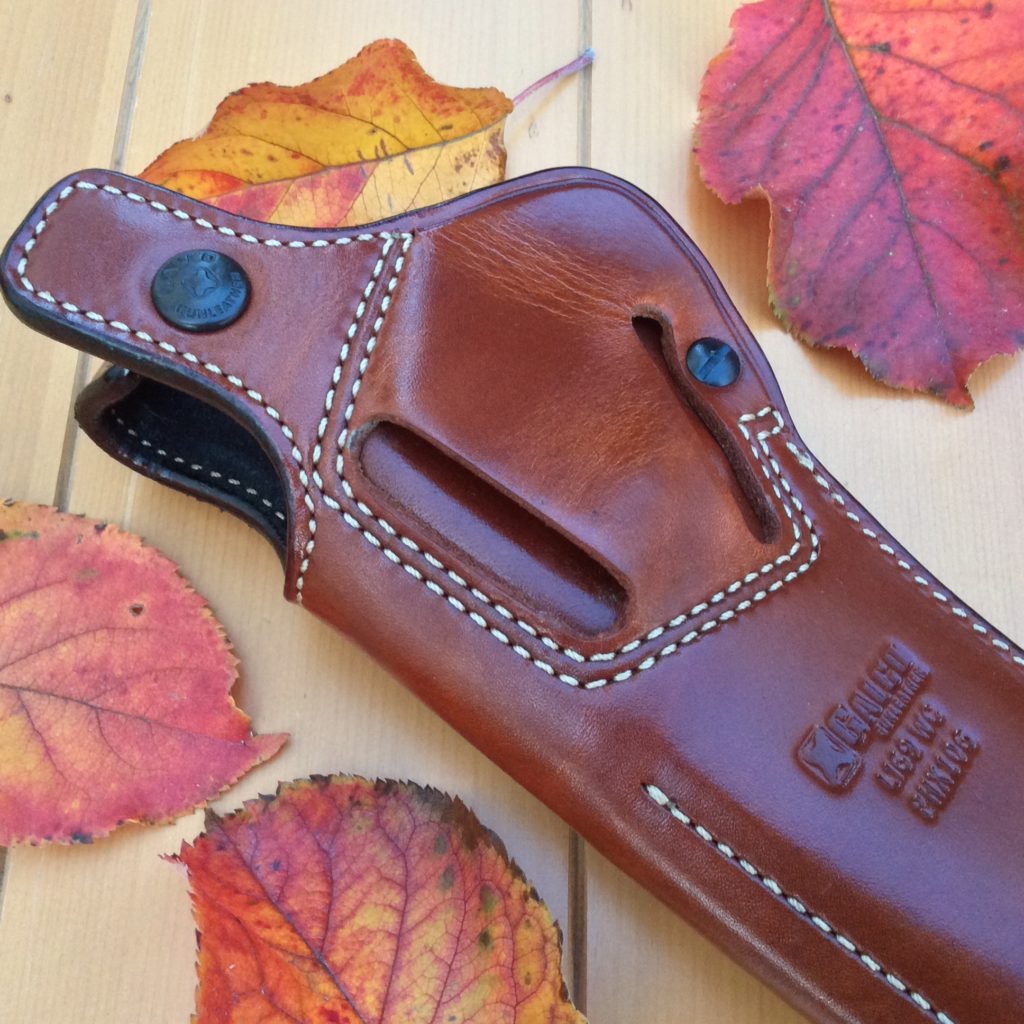
I’ve never been a fan of carrying a gun in the crossdraw position, so I only carried the Phoenix on my strong side, but for those of you who enjoy carrying in that position, the Phoenix can scratch your itch.
The Phoenix covers as much of the gun as possible with premium saddle leather, providing excellent protection for the gun while you’re in the field. The holster is only relieved as necessary to obtain a full firing grip on the gun while it’s in the holster. The afforded grip was excellent, with no interference, on the Phoenix.
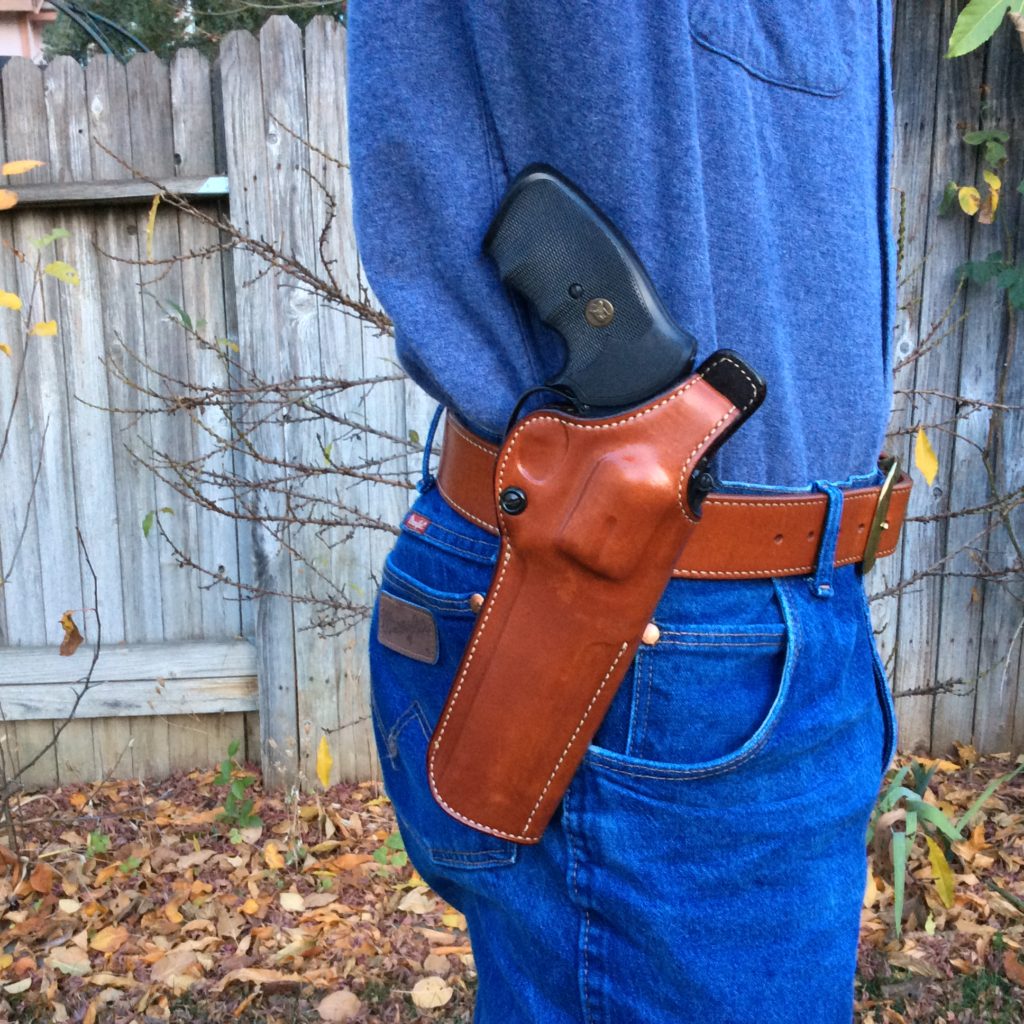
A thumb break secures the gun in the holster, and gets some additional help from a tension screw at the forward edge of the trigger guard. Some models of the Phoenix have an additional tension screw at the rear edge of the holster, under the barrel, to help tailor the fit of the pouch to the gun and thus, the draw resistance. When the Model 586 was put into the holster for the first time, it was a bit of a wrestling match to get that thumb break snapped closed around the semi-target hammer, but that’s a good thing. An inexperienced hand might think the holster was improperly fit, but a RevolverGuy knows that thumb breaks need to start out tight because the leather will stretch a bit as it’s broken in, and we can’t afford for them to get sloppy. The thumb break on this Phoenix held the line and secured the gun, but opened easily when it was time.
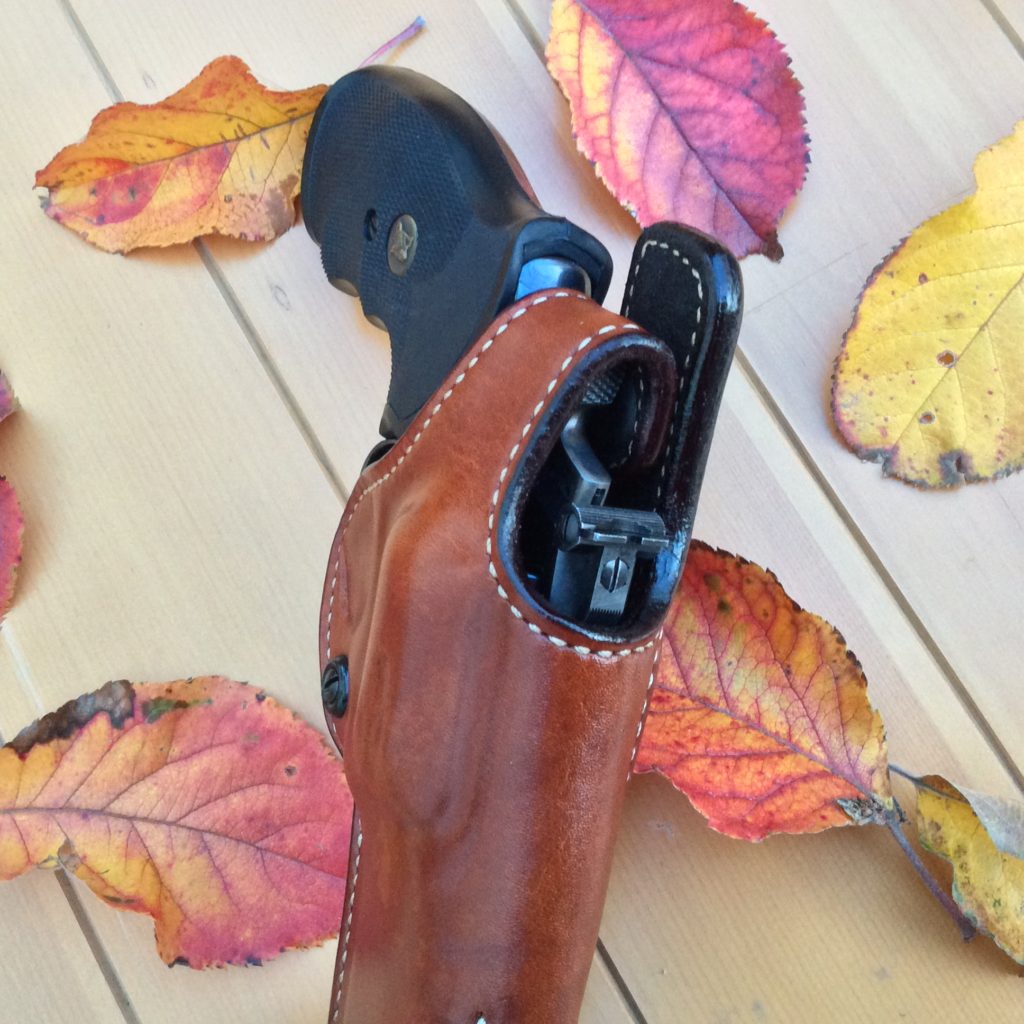
One feature I particularly appreciated about the Phoenix was the fully covered trigger guard. Back in the days when Ronaldus Magnus graced the White House and the Dan Wesson name only appeared on revolvers, I purchased several Bianchi #5BHL holsters for guns that I wanted to carry. The Bianchi #5BHL is a strong side thumb break design that has a lot in common with the Phoenix, but it follows the fashion of an earlier era by leaving the trigger guard fully exposed on the models built for double action revolvers. This was cutting edge design at the turn of the 20th Century, when pistoleros were encouraged to get their trigger finger onto the trigger early in the draw stroke, but almost two decades into the 21st, we’ve come to the realization that the trigger finger needs to be a little more patient, and holsters should fully cover the trigger guard for safety. The Phoenix fixes the glaring flaw of the earlier 5BHL nicely.
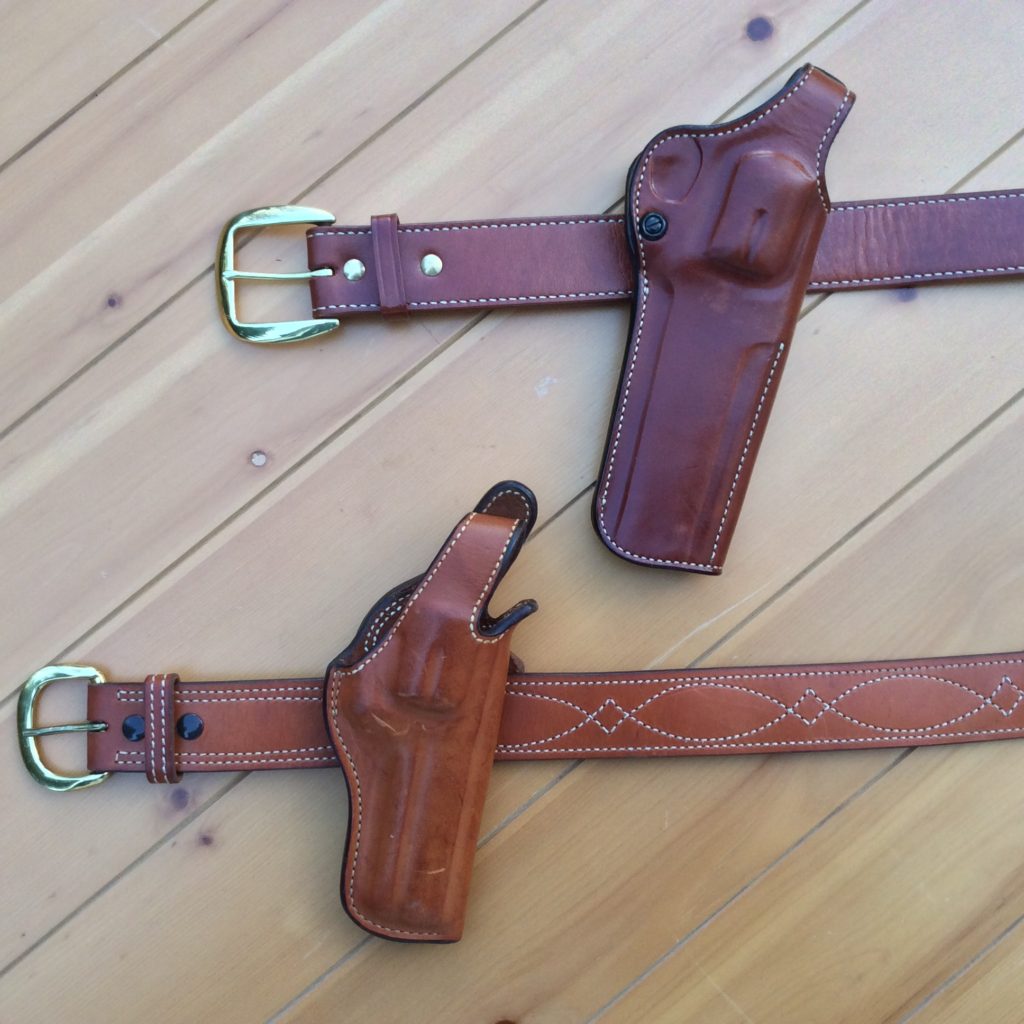
Another improvement over the older Bianchi design is the incorporation of two leather strips on the interior of the leading edge of the holster, which create a track for the front sight to ride in. The sight rails help to prevent the front sight from dragging on the holster during the draw, and work particularly nice for the Patridge-style sight on this Model 586, with its square edges and sharp corners. The older 5BHL has a molded track for the front sight that works well, but the stitched sight rails of the Phoenix are a solid advance.
One feature on the 5BHL that I missed on the Phoenix was the provision to “straddle” a belt loop on the pants. On the 5BHL, the loop is slotted so that a user can thread the belt through the rear part of the tunnel, exit through the first belt slot, thread underneath the pants belt loop, then thread back into the last belt slot and out the tunnel again. In this fashion, the holster can be positioned “on top” of the belt loop if that’s where the user wants to carry it. On the Phoenix, the belt loop on the holster has to ride in front of or behind the belt loop on the pants, which sometime limits your ability to place the holster exactly where you want it, especially on many of the new “tactical style” pants with their wide belt loops. I would have liked to move the ride of the Phoenix around a little bit, but the belt loop on my Wrangler jeans prevented me from putting it in the sweet spot. The Phoenix is made without this feature to accomodate the crossdraw option instead, but I’d like to see a strong side-only model with the extra slots in the loop like the old 5BHL, because I have no plans to carry crossdraw with this holster.
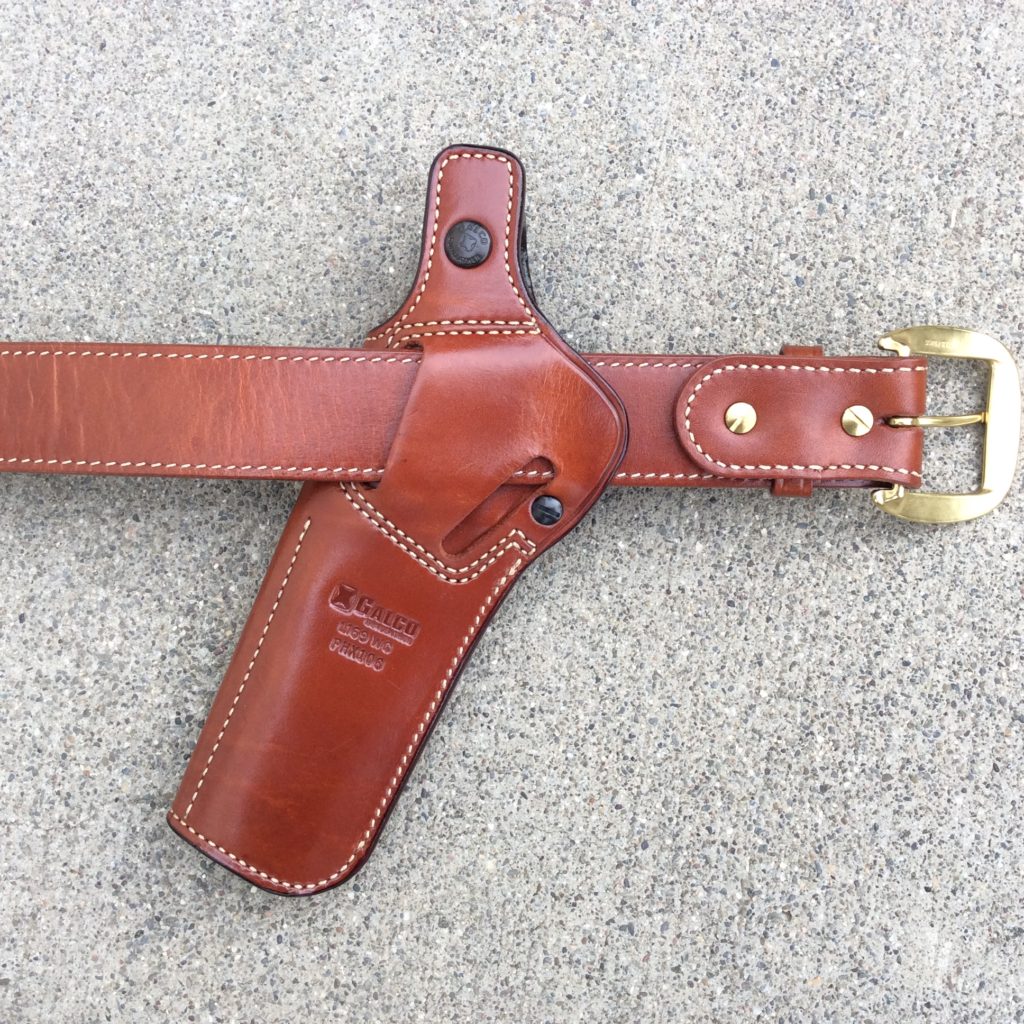
The pouch is nicely boned for the gun, and is cut long enough to protect the crown of the muzzle. The muzzle is left open, which will allow some debris and water to exit, but also allow mud and snow to plug the muzzle if the wearer is not careful. Fortunately, the forward cant of the holster helps to keep the muzzle clear of things on the long, six-inch gun, even when sitting.
The materials on the Phoenix, like those of the SB5 Sport Belt, are excellent. The holster is made of premium saddle leather that will keep its shape and protect the gun from damage in the outdoors. The leather has the same beautiful color as the SB5 belt, and is properly sealed for moisture resistance. The holster also has a silicone-impregnated suede lining that will help to protect the finish on the gun. A word to the wise here—if you spend lots of time in dusty environments, that dust will collect on the suede lining and act like fine sandpaper each time you draw and reholster your gun, so brush out the lining periodically to keep it clean and protect your finish.
The holster is stitched in the same manner as the SB5 belt, making them both an incredibly handsome pair, together. The stitching is doubled up on the high stress areas around the belt loops on the rear panel.
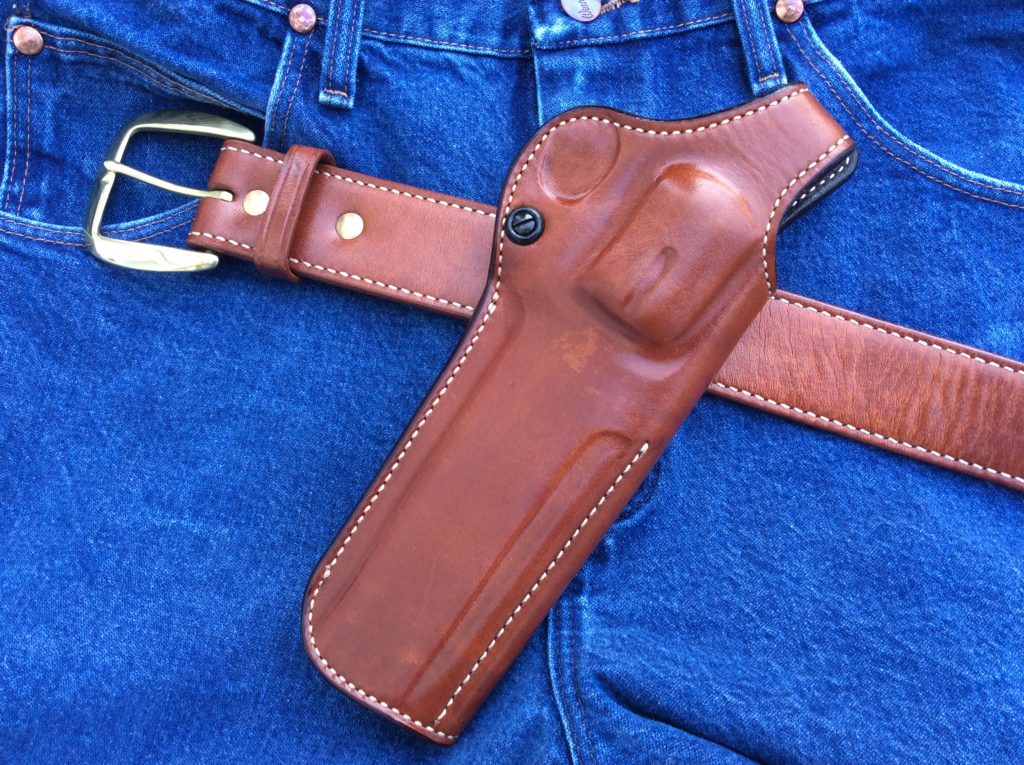
The Model 586 fit in the holster perfectly, and the holster carried it comfortably on the hip. I prefer a holster with a neutral cant and think a gun comes out easier from a vertical holster, but the forward cant on the Phoenix sure makes carrying a 6” revolver a lot easier and would probably be really helpful in the field. The holster rides snugly against the body with the long barrel tucking nicely into the side of the leg and buttocks, offering a no-snag profile.
The 1-3/4” SB5 belt fit the belt loops on the Phoenix perfectly, and there was absolutely no shifting around of the holster during activity. When the leather stretches out a bit it will be easier to thread the holster onto the belt, but based on past experience with quality holsters like this, the fit will be maintained and the holster will stay where you put it.
Summary
I was impressed by the Galco Dual Position Phoenix Belt Holster and SB5 Sport Belt. These are really solid designs made with care from great materials. Even though these are “production quality” items, the care with which they are made rivals some of the custom work I’ve seen from other makers. I know that Justin’s experience with the Walkabout was rightfully disappointing (he liked the Galco Tuck N Go a lot, however), but based on my personal experience, the Phoenix and Sport Belt are more representative of the quality that you’re likely to find in the pages of the Galco catalog. I bought my first Galco holster in 1990 and it’s been joined by several more, since. I’ve never been disappointed by them.
The little Famous Jackass Leather Company outgrew its old home, but Galco International didn’t outgrow its roots. The company is still making high quality gun leather, despite its size, and I highly encourage RevolverGuys to check them out.

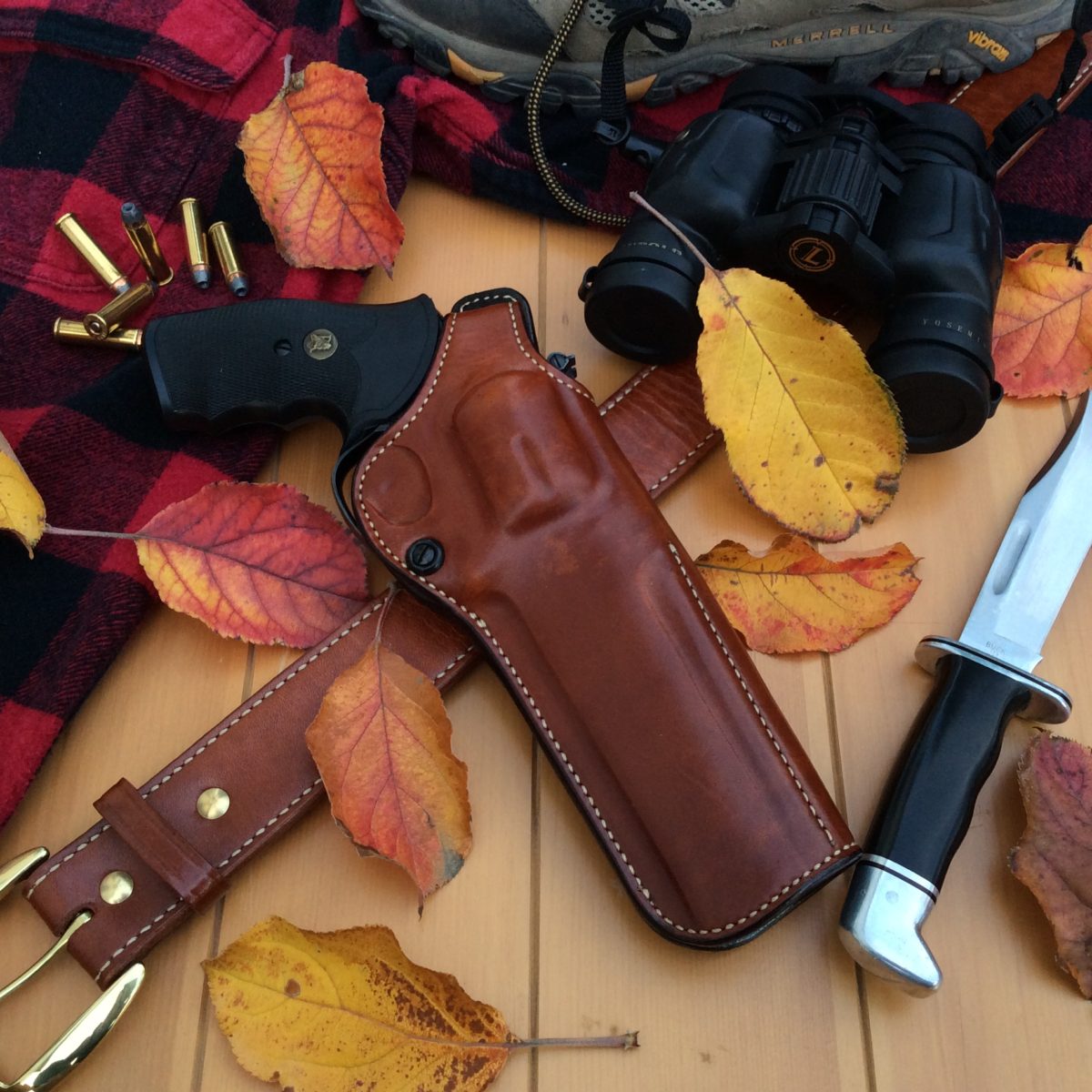
Yup, the Galco products are good.
The “torso photo” showing the gun being
worn close in illustrates, I think, an ability
to carry such a large gun concealed with the’
proper length jacket.
In this day and age, the emphasis is on the
small J-frame sized guns because of weight
and the ability to make them “pocket” guns.
But I remember when police detectives carried
full sized duty guns, not necessarily the 6-inch
variety, and did so fairly easily under their
jackets, suit coats.
With the right holsters, it can be done.
Agreed Sir! The right belt and holster combo can make it work nicely. A revolver can carry real close to the body if the cylinder is positioned above the belt line. The cylinder will fill the concave area where your hip curves inward, aiding concealment.
Nice review Mike. The only thing that smells better than Hoppes is fine leather! Finding quality, functional leather these days for wheelguns can be a bit of a chore. Lots of ill fitting cordura and foam, but something truly functional takes some hunting…and $$$. Another option is the DeSantis 001 series. (Thumbreak model). It’s quality is on par with the Galco, and is more of a concealment rig. I have one for my .44spl GP100. With a light covershirt, even the big Ruger disappears. Very functional.
I think Justin needs to put you to work further reviewing fine leather and carry options for our favorite sidearms. Maybe a sidetrack into single malt scotch and finely brewed porters as well.
Jim,
I’m not entirely convinced that it takes much hunting to find decent leather holsters, but I will agree the list of non-custom manufacturers is pretty small (I think all the good ones may have been mentioned in this article and your comment: Galco, Bianchi, and DeSantis), and money does become a concern pretty quick.
I make most of my own leather holsters, but I am also always looking for ways to improve, so I would second your suggestion of more reviews of leather goods. Ditto the single malts and porters (but no IPAs, thank you very much; those should be reserved for the plastic, striker-fired, autopistol crowd).
Thanks Jim! DeSantis makes a wonderful holster and I am planning to review some of their gear soon. I’m no expert on scotch, but I’m not opposed to learning, if you’re buying. ; ^ )
I personally don’t care for the blockiness of the molding for the barrel, and I would like to see a little less molding around the top of the cylinder. That said, neither of those is a deal breaker and the rest of the holster looks very nice. I actually like the spot right below the cylinder that obviously took moisture differently and what looks like a very fine range scar towards the end of the barrel. That kind of character is part of what makes leather holsters great.
I’ve never owned any Galco holsters, but my impression is that their non-suede options are good. I personally would avoid any holster made from suede (or center cut steer hide, as Galco likes to call it) regardless of manufacturer, as I think it is just generally a horrible material choice. The problem is telling the difference between rough-out full-grain leather options (like the Tuck-n-Go or the pocket holster shown in this article) and the suede options (like the Walkabout) easily.
P.S. It took me way too long to figure out why you kept insisting on threading your belt through the holster loops backwards. I’m going to blame having been sick for a few days combined with not be a morning person for not remembering that *I’m* the one who does it backwards because I shoot left handed.
I agree Greyson. The only use for suede in holsters is as a lining, I think.
So, a Southpaw, eh? You’re going to have to write us a story someday about the best ways to run a revolver when you’re a person that operates in their right mind. ; ^ )
I never claimed to be in my right mind! I am right handed, so I don’t get to use that argument (my left handed wife makes sure of that). I am, however, left-eye dominant, and shooting left handed leads to way more consistency due, I assume, to better gun/forearm alignment.
Ironically, my wife is also cross-dominant, so we still have to consider ambidextrous use for everything anyway. Lefty-friendly guns for me, and lefty-friendly everything else for her.
Very interesting! I’ve taught lots of cross-dominant shooters, and my general experience has been that they shoot best when the handgun is in their “strong” hand. It seems like they deal better with switching eyes (or canting/turning the head to use their dominant eye) than they do switching hands. You’re the first I’ve met who prefers putting the gun in the other hand. Very cool.
FWIW, I do a lot of “weak hand” pistol shooting and having my dominant eye on the other side never seems to be an issue. Then again, I typically shoot with both eyes open anyhow, only closing the off side when I need to take a hard focus for a long distance shot.
I suppose this is one of those things that’s a bigger problem if you’re shooting a long gun.
I don’t know if it is an issue with strength of dominance, poor training, weak grasp/wrists, or some other scenario, but even using two hands and keeping both eyes open, the gun comes up to the left of center for me. When I do that right-handed, it leads to a bent wrist, needing to lay my right ear on my shoulder (or really close to it), or roting the gun almost 45 degrees counter clockwise. The second two options are not natural for me, so the first one happens most readily. As a result, it was easier to just shoot left handed. I’m not saying it is the right solution; it is just the one I’ve been using for about 16 years.
I do find rotating the gun is a bit easier if I am shooting single handed, and about 80% of my right handed shooting is done that way. In that regard, it is not too bad to switch back and forth, and I can still hit right handed without too much embarrassment. I just get better results left handed, and I am not a good enough handgun shooter to be comfortable with *any* unnecessary degradation in performance.
I’m concerned that I am getting the comments section a bit too off topic, but I would be happy to continue this conversation as part of a discussion of eye dominance, training choices, or any other relevant article.
I will have to take a look, as I am in the market for a full-flap crossdraw. Concealment is not an issue as it is a woods gun, but keeping crud out of the holster and gun while working is mandatory.
Old School, if you’re looking for a crossdraw with a flap, check out Simply Rugged Holsters–they have two to choose from that might suit your needs (the Flap Jack and the All American) . Tell them RevolverGuy sent you!
Will do and thanks, Mike. The GP100 to fill that holster is on the way to my dealer now.
Man, that is probably going to be a tall order. I didn’t see any Galco or Bianchi full flap holsters, and the only one DeSantis makes appears to be intended specifically for the Pedersoli Howdah 10″.
The only options that comes to mind are the All American Full Flap and the Flap Jack holsters from Simply Rugged. They are based on a 3-slot pancake design, so they can be worn cross draw, the coverage on both seems pretty good, he makes them for just about any revolver you are likely to have, and the price, while higher than I like*, isn’t unreasonable. Since we are back in the realm of “mom & pops”, you are looking at 2-3 weeks for delivery if you don’t have any decorative carving done, but at least they have something that might fit your needs.
* To be fair, I think a good quality leather holster should cost $35 even though I am reasonably certain that has never been the case while I’ve been alive. I’m just cheap.
LOVE those Simply Rugged Flap holsters. I’ve seen them before, and since the holster is going to be buried with me, I’m willing to shell out the money for a quality product.
Link is here for those interested:
Flap Jack: https://www.simplyrugged.com/ecommerce/Flap-Jack-Leather-Holster.cfm?item_id=164&parent=669
All American Full Flap: https://www.simplyrugged.com/ecommerce/All-American-Full-Flap-Pancake-Leather-Holster.cfm?item_id=385&parent=669
That dude wearing the Flapjack across his chest sends me running for the hills. And sells the product nicely.
Good review. I wish Galco offered this model for the GP100 3″. It seems the only leather offering they have for that model is one that leaves a bit of the barrel exposed, which is a deal killer for me in a field holster.
I’ve got a Bianchi ‘Cyclone’ for my 5.5″ Redhawk, which is very similar to the Phoenix, with a hammer strap.
I would also second the Simply Rugged recommendations – they made me a pancake holster for my LCRx 3″ that is absolute perfection. You get what you pay for with SR.
Hammer, welcome aboard and thanks for the SR testimonial. We’ve got to talk to him about getting a T&E to review. I’ve been admiring his work from a distance for too long.
Blue steel and Gunleather (to borrow a title from John Bianchi)… exactly as God intended!
Thanks, Mike. I never tire of the natural harmony that comes from a man-size revolver resting perfectly in good leather. I own one Kydex holster – a reluctant acknowledgement that that does indeed seem to work best when appendix- carrying a 1911 – but the rest are all leather. Bianchi, Galco, Milt Sparks, TT leather. When I bought my Model 69 a few months ago the first thing I did, before even putting a round through it, was to jump on El Paso Saddlery’s website and order up a 1920 Crossdraw.
And amen on the belt being so critical. It’s always a bit of a conundrum pairing up a full-size handgun with dress or dress-casual slacks. Too much gun on too little belt will aggravate you like few things in this world! I heartily endorse the rather more relaxed sartorial expectations in vogue today.
Looking forward to the next one…
Thank you Sir! We always enjoy hearing your commentary here!
I am looking for a good-quality gunbelt. I have carried my 586 in a pancake holster that I designed and built myself, on a 1 1/4″ belt to a movie and shopping…total ~ 6 hours, and although I had no problems at all, I have thought from that time that a 1 1/2″ double thickness belt would be better, and, I could weat it with my dress pants when I am not carrying..
Carl, welcome aboard! I just finished an article on gun belts that you’ll see here soon. I think you’ll find it to be helpful. Stay tuned!